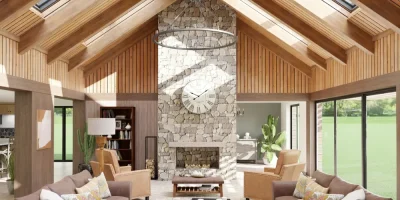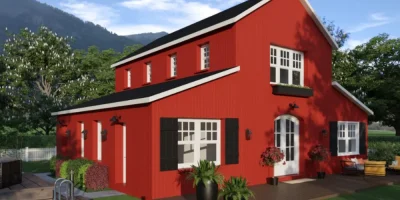New home construction is up! In March 2022, about 1.6 million homes were under construction — the highest it’s been since 1973.
Sounds like good news for the housing market right? More homes under construction means more houses on the market which should help ease the massive housing shortage… sounds simple enough.
Sadly it’s not that simple.
The global supply chain issues have exacerbated the housing shortage in ways no one could’ve ever anticipated. It’s made numbers that are usually a good sign — like the number of homes under construction — become indicators of a larger problem that may not be resolved anytime soon.
- So how are the supply chain issues affecting new home construction?
- What does this mean for home builders and other housing professionals like you?
- And is there any end in sight?
Find out in this 5-minute read.
Back Orders Leaving Construction Projects Pending
So how have supply chain issues affected new home construction?
You might think that since more homes are “under construction” supply chain issues aren’t affecting builders that much. If builders are building, they have supplies, right?
Wrong.
Keep in mind that “under construction” doesn’t necessarily mean builders are actively working on those homes. Really, a better term to use right now instead of “under construction” is “unfinished”.
Yes, there is currently a record number of unfinished homes. Doesn’t sound as positive now does it?
How has the supply chain disruption contributed to this?
Basically, thousands of homes remain unfinished as builders are waiting on back-ordered supplies.
Maybe it’s a garage door, windows, plumbing fixtures, or HVAC equipment. Either way, if you don’t have key supplies to finish the home, there it sits — unoccupied, unfinished, and technically still “under construction”. You’ve probably experienced this first-hand.
So how long will this keep going? When will builders get the supplies they need to move the projects from pending to completed and ease the housing shortage?
When will the Supply Chain Issue be Resolved?
Most experts say the supply chain issues will continue through 2022 and likely into 2023. They also expect conditions to improve gradually.
The global supply chain is complicated and that makes it difficult to predict when it will get straightened out. Plus, just like any chain, it’s only as strong as its weakest link.
- One month, that weak link is factory shutdowns in China because of COVID lockdowns.
- Then the factories get up and running, but now all those products get backlogged at U.S. ports because there’s no space to unload the containers.
- Later, the weak link becomes a shortage of truck drivers. So trucking companies raise their pay and hire more workers.
- But then a new weak link presents itself — a shortage of truck chassis for hauling containers.
All the while a home builder is waiting for a shipment of windows to finish a house under construction.
With so many interconnected moving parts, predicting when the supply chain will be back to normal becomes a guess at best. And that’s not taking into account any new COVID-19 variants that could throw a monkey wrench into the supply chain again.
But if everything continues as it is now, we can expect these issues to continue for at least a few more months. Then gradually things should start to improve.
- Back ordered supplies will finally arrive.
- Builders will finish homes
- The housing shortage will gradually ease
Meanwhile, what does this mean for home builders like you? Learn more in the next section.
What does this mean for Home Builders?
The biggest thing this means for home builders is waiting. You’re just going to have to be patient and help your buyers be patient as well.
You may even have to limit how many homes you sell because you know you won’t be able to complete them on time.
While you’re waiting to finish current projects or planning on starting new ones, here are a few more practical steps you can do to help your new home builds move along as fast as possible.
- Leave extra buffer room in your project timelines. In 2022 you can pretty much expect to get held up at some point because of supply chain issues. So plan extra buffer time into your schedules.
- Add some buffer into your budget. Maybe you planned on installing a certain type of window, but now they’re on backorder and the only windows available are more expensive. If you’ve got a buffer in your budget, you could go with the more expensive option in order to keep moving forward with your project.
- Present home buyers with options. If one type of fixture is on backorder, give home buyers other options that are in stock.
*Use an estimating software like the CostCertified integration with Cedreo so you can easily present clients with a variety of options and then automatically update your budget.
How is this affecting the Housing Market?
The current housing shortage has made this a seller’s market. Sellers hold the power and buyers are forced to compete with each other for whatever homes are on the market, regardless of the prices sellers are asking.
Combine that with mortgage rates that have increased to over 5% (the highest in a decade) and buying a home has gotten more expensive than ever.
In some ways, that could help ease the shortage since the rising prices will likely cause many buyers to hold off on buying a home for now. However, it’ll take some time to see how this affects the market.
Hopefully, in the second half of 2022, the market will find a better balance between buyers and sellers. That could happen if:
- Supply chain issues ease and builders finish homes currently under construction.
- Buyers reevaluate their budgets and decide to hold off on buying a home.
- Fewer supply chain issues mean home builders can take on a higher volume of new construction projects which will continue to ease the shortage and bring balance to the buyer/seller relationship.
Conclusion
Supply chain issues holding up your new construction projects? You’re not alone. Thousands of builders, realtors, and housing professionals are in the same boat.
The best thing for you to do now while waiting for things to improve is to be adaptable, plan ahead and get ready to move forward with your projects in the near future.
A great way to do that is with Cedreo and the CostCertified integration.
- Design new homes in as little as 2 hours
- Make changes to the designs on the fly
- Create flexible estimates based on available supplies



